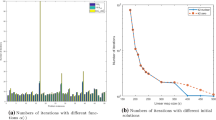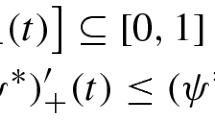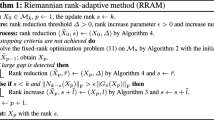Abstract
This paper considers a rank-constrained optimization problem where the objective function is continuously differentiable on a closed convex set. After replacing the rank constraint by an equality of the truncated difference of L1 and L2 norm, and adding the equality constraint into the objective to get a penalty problem, we prove that the penalty problem is exact in the sense that the set of its global (local) optimal solutions coincides with that of the original problem when the penalty parameter is over a certain threshold. This establishes the theoretical guarantee for the truncated difference of L1 and L2 norm regularization optimization including the work of Ma et al. (SIAM J Imaging Sci 10(3):1346–1380, 2017). Besides, for the penalty problem, we propose an extrapolation proximal difference of convex algorithm (epDCA) and prove the sequence generated by epDCA converges to a stationary point of the penalty problem. Further, an adaptive penalty method based on epDCA is constructed for the original rank-constrained problem. The efficiency of the algorithms is verified via numerical experiments for the nearest low-rank correlation matrix problem and the matrix completion problem.


Similar content being viewed by others
Data availability statement
All data included in this study are available upon request by contact with the corresponding author.
References
Attouch, H., Bolte, J.: On the convergence of the proximal algorithm for nonsmooth functions involving analytic features. Math. Program. 116(1–2), 5–16 (2009)
Attouch, H., Bolte, J., Redont, P., Soubeyran, A.: Proximal alternating minimization and projection methods for nonconvex problems: an approach based on the Kurdyka-Łojasiewicz inequality. Math. Oper. Res. 35, 438–457 (2010)
Attouch, H., Bolte, J., Svaiter, B.F.: Convergence of descent methods for semi-algebraic and tame problems: proximal algorithms, forward-backward splitting, and regularized GaussSeidel methods. Math. Program. 137(1–2), 91–129 (2013)
Bi, S.J., Pan, S.H.: Error bounds for rank constrained optimization problems and applications. Oper. Res. Lett. 44(3), 336–341 (2016)
Bolte, J., Sabach, S., Teboulle, M.: Proximal alternating linearized minimization for nonconvex and nonsmooth problems. Math. Program. 146(1–2), 459–494 (2014)
Bolte, J., Daniilidis, A., Lewis, A.: The Łojasiewicz inequality for nonsmooth subanalytic functions with applications to subgradient dynamical systems. SIAM J. Optim. 17(4), 1205–1223 (2007)
Burer, S., Monteiro, R., Yin, Z.: Maximum stable set formulations and heuristics based on continuous optimization. Math. Program. 94(1), 137–166 (2002)
Burer, S., Monteiro, R.: A nonlinear programming algorithm for solving semidefinite programs via low-rank factorization. Math. Program. 95(2), 329–357 (2003)
Cai, J., Candes, E.J., Shen, Z.: A singular value thresholding algorithm for matrix completion. SIAM J. Optim. 20(4), 1956–1982 (2010)
Cai, T., Zhang, A.: ROP: Matrix recovery via rank-one projections. Ann. Stat. 43(1), 102–138 (2015)
Delgado, R.A., Aguero, J.C., Goodwin, G.C.: A rank-constrained optimization approach: application to factor analysis. IFAC Proc. Vol. 47(3), 10373–10378 (2014)
Fazel, M.: Matrix Tank Minimization with Applications. Standford University (2002)
Gao, Y., Sun, D.F.: Calibrating least squares semidefinite programming with equality and inequality constraints. SIAM J. Matrix Anal. Appl. 31(3), 1432–1457 (2009)
Gao, Y., Sun, D.F.: A majorized penalty approach for calibrating rank constrained correlation matrix problems, Technical report, Department of Mathematics, National University of Singapore, Singapore (2010)
Gengy, T., Sun, G., Xu, Y., He, J.: Truncated nuclear norm minimization based group sparse representation for image restoration. SIAM J. Imag. Sci. 11(3), 1878–1897 (2018)
Gillis, N., Glineur, F.: Low-rank matrix approximation with weights or missing data is NP-hard. SIAM J. Matrix Anal. Appl. 32(4), 1149–1165 (2011)
Gotoh, J.Y., Takeda, A., Tono, K.: DC formulations and algorithms for sparse optimization problems. Math. Program. 169(1), 141–176 (2018)
Grossmann, C., Jones, C., Morari, M.: System identification with missing data via nuclear norm regularization, Control Conference. IEEE (2009)
Hu, W., Wang, Z., Liu, S., Yang, X., Yu, G., Zhang, J.: Motion capture data completion via truncated nuclear norm regularization. IEEE Signal Process. Lett. 25(2), 258–262 (2017)
Hu, Y., Zhang, D., Ye, J., Li, X.: Fast and accurate matrix completion via truncated nuclear norm regularization. IEEE Trans. Pattern Anal. Mach. Intell. 35(9), 2117–2130 (2013)
Kim, S.J., Moon, Y.H.: Structurally constrained \(H_{2}\) and \(H_{\infty }\) control: a rank-constrained LMI approach. Automatica 42(9), 1583–1588 (2006)
Lai, M.J., Xu, Y., Yin, W.: Improved iteratively reweighted least squares for unconstrained smoothed lq minimization. SIAM J. Numer. Anal. 51(2), 927–957 (2013)
Liu, T., Pong, T.K., Takeda, A.: A refined convergence analysis of \(pDCA_{e}\) with applications to simultaneous sparse recovery and outlier detection. Comput. Optim. Appl. 73(1), 69–100 (2019)
Liu, T., Lu, Z., Chen, X., Dai, Y.: An exact penalty method for semidefinite-box-constrained low-rank matrix optimization problems. IMA J. Numer. Anal. 40(1), 563–586 (2020)
Lu, Y., Zhang, L., Wu, J.: A smoothing majorization method for matrix minimization. Optim. Methods Softw. 30(4/6), 682–705 (2015)
Lu, Z., Zhang, Y., Li, X.: Penalty decomposition methods for rank minimization. Optim. Methods Softw. 30(3), 531–558 (2015)
Lu, Z., Yong, Z., Jian, L.: \(L_{p}\) regularized low-rank approximation via iterative reweighted singular value minimization. Comput. Optim. Appl. 68(3), 1–24 (2017)
Ma, T., Lou, Y., Huang, T.: Truncated l1–l2 Models for sparse recovery and rank minimization. SIAM J. Imaging Sci. 10(3), 1346–1380 (2017)
Markovsky, I.: Structured low-rank approximation and its applications. Automatica 44(4), 891–909 (2008)
Nguyen, L.T., Kim, J., Shim, B.: Low-rank matrix completion: a contemporary survey. IEEE Access 7, 94215–94237 (2019)
Pham, D.T., Le, T.H.A.: Convex analysis approach to D.C.programming: theory, algorithms and applications. Acta Math. Vietnam 22(1), 289–355 (1997)
Qian, Y., Pan, S.: Relaxation approaches to a class of UBPPs based on equivalent DC penalized matrix programs, arXiv e-prints (2020)
Rockafellar, R.T., Wets, R. J-B.: Variational Analysis. Springer (1998)
Schneider, R., Uschmajew, A.: Convergence results for projected line-search methods on varieties of low-rank matrices via Łojasiewicz inequality. SIAM J. Optim. 25(1), 622–646 (2015)
Vandereycken, B.: Low-rank matrix completion by Riemannian optimization. SIAM J. Optim. 23(2), 1214–1236 (2013)
Wen, B., Chen, X., Pong, T.K.: A proximal difference-of-convex algorithm with extrapolation. Comput. Optim. Appl. 69(2), 297–324 (2018)
Wu, L.X.: Fast at-the-money calibration of the LIBOR market model using Lagrange multipliers. J. Comput. Finance 6, 39–77 (2003)
Zeng, W.J., So, H.C.: Outlier-robust matrix completion via \(l_{p}\)-minimization. IEEE Trans. Signal Process. 66(5), 1125–1140 (2017)
Zhang, Z.Y., Wu, L.X.: Optimal low-rank approximation to a correlation matrix. Linear Algebra Appl. 364(1), 161–187 (2003)
Acknowledgements
The authors would like to thank anonymous referees for their comments and Prof. Shaohua Pan in South China University of Technology for her helpful advice, which enabled us to improve the quality of the paper.
Funding
This work is supported by National Natural Science Foundation of China (11971177), Guangdong Basic and Applied Basic Research Foundation (2021A1515010210).
Author information
Authors and Affiliations
Corresponding author
Ethics declarations
Conflict of interest
The authors declare that they have no conflicts of interest to this work.
Additional information
Publisher's Note
Springer Nature remains neutral with regard to jurisdictional claims in published maps and institutional affiliations.
Appendices
Appendix 1: The proof of the Lemma 4.1
Proof
(a) Fix any \(\alpha \in \mathbb {R}\). Consider the level set \(\ell _\alpha (g):=\{x\in \mathbb {R}^d \ |\ g(x)\le \alpha \}\). Notice that
Since g and \(\{(x,t)\in \mathbb {R}^d\times \mathbb {R}\ |\ t=\alpha \}\) are semialegbraic, we conclude that \(\ell _\alpha (g)\) is semialegbraic.
(b) By the definition, \(\Vert X\Vert\) can be written as
Since Euclidean unit ball is a semialgebraic set [2], it holds that spectral norm \(\Vert X\Vert\) is a semialgebraic.
Next, we prove \(\Vert \cdot \Vert _h\) is semialgebraic. Since composition of semialgebraic functions are semialgebraic and \(\Vert \cdot \Vert _h:=h(\sigma (\cdot ))\), we only need to show that the function h is semialgebraic. Let \(h_1(x):={\textstyle \sum _{i=1}^{r-1}}|x|_i^{\downarrow }\) and \(h_2(x):=\sqrt{{\textstyle \sum _{i=r}^q}[|x|_i^{\downarrow }]^2}\). Notice that finite sums of semialgebraic functions are semialgebraic. Thus, it suffices to prove that \(h_1(x)\) and \(h_2(x)\) are semialgebraic. For a positive integer q, we let \(S_q\) denote the set of all possible permutations of \(\{1, \ldots , q\}\). For each fixed permutation \(\sigma \in S_q\), define
then we have \(\bigcup _{\sigma \in S_q} \Omega _\sigma = \mathbb {R}^q\). Thus, for any \(x\in \mathbb {R}^q\), there exists a permutation \(\sigma \in S_q\) such that \(x\in \Omega _\sigma\), \(h_1(x)={\textstyle \sum _{i=1}^{r-1}} |x_{\sigma (i)}|\) and \(h_2(x)=\sqrt{{\textstyle \sum _{i=r}^q}x_{\sigma (i)}^2}\). The graph of \(h_1(x)\) is the set
Since the set \(\{ (x,t)\in \mathbb {R}^q \times \mathbb {R}_+ \ | \ {\textstyle \sum _{i=1}^{r-1}} |x_{\sigma (i)}|= t\}\) is semialgebraic and the number of \(S_q\) is finite. Hence the graph of \(h_1(x)\) is semialgebraic, and then the function \(h_1(x)\) is semialgebraic. Next, we consider the graph of \(h_2(x)\),
Using a similar argument as above, one can see that the function \(h_2(x)\) is semialgebraic.
For the function \((\Vert \cdot \Vert _h)^*\), we have by the definition of conjugate function
where \(\mathbb {B}:=\{Z\in \mathbb {R}^{m\times n} \ | \ \Vert Z\Vert _h{_*}\le 1\}\) denotes the unit ball on \(\Vert \cdot \Vert _h{_*}\). Notice that \(\Vert \cdot \Vert _h{_*}\) is the dual norm of \(\Vert \cdot \Vert _h\) and \(\Vert \cdot \Vert _{h^*}=\sup _{\Vert Z\Vert _h\le 1}\langle \cdot ,Z\rangle .\) From Lemma 4.1 (a) and the result that \(\Vert \cdot \Vert _h\) is semialgebraic, we get that \(\{Z\in \mathbb {R}^{m\times n}\ | \ \Vert Z\Vert _h\le 1\}\) is a semialgebraic set, which implies the dual norm \(\Vert \cdot \Vert _{h^*}\) is a semialgebraic function and then \(\mathbb {B}\) is a semialgebraic set. By the fact that indicator function of semialgebraic set is semialgebraic function [2], we get the result that \((\Vert \cdot \Vert _h)^*\) is semialgebraic.
Therefore, the proof is complete. \(\square\)
Appendix 2: The proof of the Lemma 4.2
Proof
From [2], the correlation matrix set is semialgebraic. Since \(\Vert \cdot \Vert\) is a semialgebraic function, then its level set is semialgebraic. The density set \(\{X\in \mathbb {S}^{n}_{+} \ | \ tr(X)=1\}\) is equivalent to \(\{X\in \mathbb {S}^{n}_{+} \ | \ \Vert X\Vert _{*}=1\}\), and the set \(\{X\in \mathbb {S}^{n}_{+} |X\preceq I\}\) is equivalent to \(\{X\in \mathbb {S}^{n}_{+} |\Vert X\Vert \le 1\}\), and thus these sets are semialgebraic. The proof is complete. \(\square\)
Rights and permissions
Springer Nature or its licensor (e.g. a society or other partner) holds exclusive rights to this article under a publishing agreement with the author(s) or other rightsholder(s); author self-archiving of the accepted manuscript version of this article is solely governed by the terms of such publishing agreement and applicable law.
About this article
Cite this article
Yang, Z., Han, L. A global exact penalty for rank-constrained optimization problem and applications. Comput Optim Appl 84, 477–508 (2023). https://doi.org/10.1007/s10589-022-00427-2
Received:
Accepted:
Published:
Issue Date:
DOI: https://doi.org/10.1007/s10589-022-00427-2




